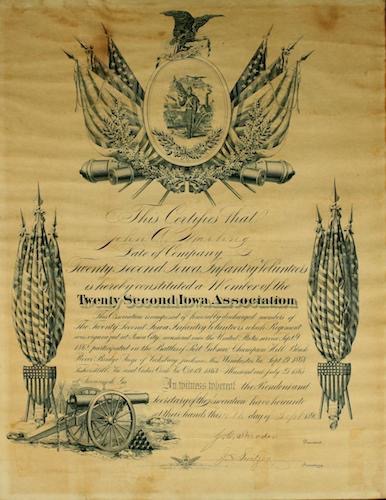
There are several people involved in the history of Jewell County who deserve to be better known. Two of these are John and Elizabeth Marling, the couple who had the misfortune to suffer one of the first attacks on white settlers in the region. Thanks to John Marling’s Indian depredation claim and Thomas Lovewell’s testimony, we know much about the incident, but comparatively little about them.
What we have long known is that the terrible assault on Elizabeth Marling and the destruction and theft of the couple’s property in July of 1866, was only the beginning of their troubles. Elizabeth was left in the care of either Moses or David Heller at Elk Creek, near Clyde, while her husband returned to Jewell County to hunt elk and buffalo to provide meat as winter approached. In October he was with pioneer Samuel Fisher and several other hunters when they were surrounded by Indians who had come to beg and swap for guns and ammunition. One Indian demanded Marling’s ornate power horn. Fisher told Marling to hand it over, which he did. However, Fisher, who had organized the hunt, made a threat under his breath as the Indian turned to leave, and was shot in the shoulder. Samuel Fisher carried a lead fragment under his shoulder blade for the rest of his life.
As Thomas Lovewell testified, the Marlings stayed in a shanty on Fisher’s property, not far from the Lovewell/Davis cabin, all that winter. When John Marling went out hunting again in March, he suffered frostbite on two toes of his right foot. The toes eventually fell off at the first joint. After John and Elizabeth traveled to Missouri to seek medical attention for John’s injured foot, their horses were turned out to run on the prairie, and came up missing at the end of April, after the White Rock Massacre.
According to the 1878 “History of Jewell County,” the Marlings lived in Fort Scott for a while, but spoke often of returning to Jewell County. They never did. I had always rooted for a happy ending for the beleaguered couple, but there was none. By 1893, when John Marling filed for an invalid pension because of his impairment, he had divorced Elizabeth on a complaint of desertion, and remarried. John and Eva Marling drifted from place to place, finally locating in Sarcoxie, Missouri, where John died in 1917.
John Marling and his first wife evidently married in 1859, but soon had to put their life together on hold when John enlisted in the 22nd Iowa Infantry, which was organized in 1862. When he requested a furlough in 1865, his commander noted that he had not been absent for a single day of his service. He wrote, "For praiseworthy conduct in all battles and skirmishes which the regiment has been engaged in, he has been excelled by none and equalled by few.” After John was discharged from the Army, the Marlings must have thought they were making up for lost time by coming to Kansas in 1866 and venturing so deep into Jewell County along White Rock Creek, that prime but dangerous land west of the big bend where the Republican River turns south. John Marling would have been about thirty years old when a hundred Cheyenne warriors descended on his claim in Jewell County and spun the couple's lives in a different direction.
My thanks to Jeffrey Burden for providing information about John Marling’s service record and his pension filing.